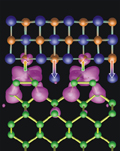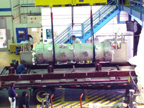Research
Highlights...
|
 |
| Number 135 |
June 23, 2003 |
|
Interface tuning is
giant step for microelectronics
 A
team led by Rodney McKee of DOE's Oak
Ridge National Laboratory has demonstrated a method to make
atomic-level changes in the functional components of semiconductor
switches. The finding by ORNL, North
Carolina State and the University of Tennessee will likely
have major implications to the semiconductor industry because
it solves a problem that has existed for decades. In a paper published
in the June 13 issue of Science, the researchers explain how to
"tune" the atomic-level zone between the substances that make
up transistors (metals, oxides and silicon). McKee describes the
work as "a unifying concept for understanding and designing" this
aspect of semiconductor physics. Until now, because of a lack
of insight, the industry had to accept the limitations that each
crucial interface within a semiconductor contains. The work was
funded by DOE's Office of Science. A
team led by Rodney McKee of DOE's Oak
Ridge National Laboratory has demonstrated a method to make
atomic-level changes in the functional components of semiconductor
switches. The finding by ORNL, North
Carolina State and the University of Tennessee will likely
have major implications to the semiconductor industry because
it solves a problem that has existed for decades. In a paper published
in the June 13 issue of Science, the researchers explain how to
"tune" the atomic-level zone between the substances that make
up transistors (metals, oxides and silicon). McKee describes the
work as "a unifying concept for understanding and designing" this
aspect of semiconductor physics. Until now, because of a lack
of insight, the industry had to accept the limitations that each
crucial interface within a semiconductor contains. The work was
funded by DOE's Office of Science.
[Ron
Walli, 865/576-0226;
wallira@ornl.gov]
|
|
NREL speeds biomass
analysis
DOE's
National Renewable Energy Laboratory
has developed new technology that takes near-infrared spectrometry,
coupled with multivariate analysis, to a new level of sophistication,
allowing scientists to analyze a biomass for energy content in
minutes. Previously it took days to determine the wide range of
physical and chemical characteristics of raw or processed biomass.
Quicker analysis promises to reduce the cost of converting biomass
to fuel or electricity. Rapid Biomass Analysis can be applied
profitably at almost any point in any industrial biomass process,
including pulp and paper manufacture or cellulosic ethanol production.
NREL is working to develop the Biomass Rapid Analysis Network
(BRAN), a consortium of industry partners that will have access
to training, technical assistance and the equipment to use the
technology.
[Sara Huntley, 303/275-4317;
sara_Huntley@nrel.gov]
|
|
INEEL researches safer,
'greener' gasoline
DOE's Idaho
National Engineering and Environmental Laboratory is seeking
to make gasoline production "greener and cleaner." INEEL's research
focuses on use of a solid acid catalyst "known as a zeolite catalyst"
to replace liquid acids currently used to form isooctane from
isobutene, increasing the fuel's octane rating. However, the catalyst
has been found to "gum up," reducing its efficiency. Washing the
catalyst periodically with a supercritical fluid extends catalyst
life by a factor of 70. Postdoctoral researcher Lucia Petkovic
is working to understand the chemical rejuvenation process. Her
success could lead to safer, cleaner production processes for
refineries everywhere.
[John
Howze 208/526-6864;
jhowze@inel.gov]
|
|
Renewable Energy Lab
announces solar cell records
The National
Renewable Energy Laboratory's National Center for Photovoltaics
(NCPV) recently announced two world records in the efficiencies
of solar cells. A conversion efficiency of 19.2% was achieved
in a copper indium gallium diselenide "thin film" cell by NREL
and a 35.2% conversion efficiency was reported for a triple-junction
concentrator cell by Spectrolab, under subcontract to the Laboratory.
This increased efficiency in converting the sun's energy is expected
to cut the cost of solar electricity. The records were announced
during the NCPV and Solar Program Review Meeting in Denver, Colo.,
in March.
[Sara
Huntley, 303/275-4317;
sara_Huntley@nrel.gov]
|
|
Jefferson Lab delivers
first production cryomodule for Spallation Neutron Source
 |
|
JLab
staff and contractors load the first "medium-beta" Spallation
Neutron Source production cryomodule onto a flatbed semi
for transport to Oak Ridge, Tenn. The 19-foot-long cryomodule
(including cold box on the front) is one of two types
of superconducting radiofrequency cryomodules Jefferson
Lab is building for SNS.
|
Jefferson Lab delivered
its first production cryomodule for the Spallation Neutron
Source superconducting linear accelerator this month (June
2003). JLab is part of a team of federal laboratories-including
Argonne, Brookhaven, Lawrence Berkeley, Los Alamos and Oak
Ridge-assisting in the design, engineering and construction
of the $1 billion-plus SNS, being built in Oak Ridge, Tenn.
Once operational, it will provide the most intense pulsed-neutron
beams in the world for scientific research and industrial
development. JLab built the prototype cryomodule last year.
After testing it was loaded onto a flatbed semi for a trial
road trip to ensure the rigors of travel wouldn't damage the
extremely sophisticated and sensitive mechanisms within the
cryomodule. After a final round of tests ensured its road-worthiness,
the cryomodule was delivered to Oak Ridge. Since then, JLab's
cryomodule production line has been in full gear. Work on
several cryomodules is well underway, each in various stages
of assembly or testing in JLab's cryomodule assembly area.
The Lab will produce 23 cryomodules for the Spallation Neutron
Source.
[Debbie
Magaldi, 757/269-5102,
magaldi@jlab.org]
|
|
ORNL
Researcher Out to Make
a Difference
 |
|
Rebecca
Efroymson
|
Rebecca Efroymson from DOE's Oak Ridge National Laboratory
isn't looking for fame, but she is looking to make a difference
to the environment and in people's lives.
That quest to make things better was evident early, as Rebecca
tutored prisoners in mathematics while earning a bachelor's
degree in biology and English from La Salle University.
"Math comes easily to me, but it isn't easy for everybody,"
says Rebecca, who received master's and doctorate degrees in
environmental toxicology from Cornell University. "I was also
intrigued by the prison environment— what it feels like
to have the door shut behind you, the social hierarchy of prisoners—and
by the main person I tutored."
She is a co-author of Ecological Risk Assessment for Contaminated
Sites, has published about 20 papers and dozens of reports and
has played a significant role in developing a multimedia model
for assessing risk from hazardous air pollutants. The task combined
her interests in the application of mathematical modeling to
environmental problems.
Rebecca recently saw her dedication and talent rewarded as
she received the Environmental Sciences Division Distinguished
Scientific Achievement Award for 2002 where she was cited "for
excellence in ecological risk assessment."
What makes for a good day, Rebecca says, is learning something
new, synthesizing new information or "writing a good chunk of
a paper." All of this is driven by her desire to ensure that
the best science is available to support policies that affect
the environment and people's lives.
Where remediation is concerned, for example, we need to do
a better job of evaluating risks and benefits of a particular
action, Rebecca says. Sometimes digging up a site and hauling
off dirt does more harm than good because it destroys vegetation,
can cause erosion and can lead to longer recovery times than
it would take the chemical contaminants to degrade.
Submitted by DOE's Oak Ridge National
Laboratory
|
|


 A
team led by Rodney McKee of DOE's
A
team led by Rodney McKee of DOE's 